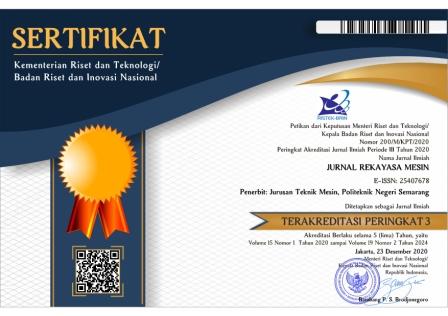Pengaruh Perbedaan Jumlah Katalis terhadap Angka Yield pada Proses Pembuatan Biodiesel dari Minyak Goreng Sisa Menggunakan Pemanas Double Jacket
DOI:
https://doi.org/10.32497/jrm.v17i1.3148Keywords:
catalyst KOH, waste cooking oilAbstract
Biodiesel is biodegradable and non-toxic and has a low carbon content, high lubricity, andBiodiesel is biodegradable and non-toxic and has a low carbon content, high lubricity, and higher ash point than diesel. The purpose of this study was to obtain data on the physicochemical properties of biodiesel from waste cooking oil (WCO) produced with different amounts of catalyst in the transesterification process. Methods This research carried out a two-step process: (1) esterification with an acid catalyst (H2SO4) and (2) transesterification with an alkali catalyst (KOH). The remaining frying oil is degummed by adding 2% H3PO4. Furthermore, the esterification process was carried out by adding 2% (v/v) H2SO4 at 800 rpm for 90 minutes. The transesterification process using an alkaline catalyst (KOH) was varied from 0.7-1.5% at a temperature of 60 oC with a rotation of 800 rpm and a time of 90 minutes. In the ester/transesterification process, the ratio of methanol: oil is 1:2 (v/v). The biofuels are then tested for cetane number, flash point, density, viscosity, calorific value, and others. The results showed that the amount of wet catalyst (KOH) in the transesterification process gave a difference in the yield of WCO oil. The optimum value was obtained at the amount of 1% KOH catalyst, which was 85%.
References
N. Damanik, H. C. Ong, C. W. Tong, T. M. I. Mahlia, and A. S. Silitonga, “A review on the engine performance and exhaust emission characteristics of diesel engines fueled with biodiesel blends,” Environ. Sci. Pollut. Res., vol. 25, no. 16, pp. 15307”“15325, 2018, doi: 10.1007/s11356-018-2098-8.
A. S. Silitonga et al., “A comparative study of biodiesel production methods for Reutealis trisperma biodiesel,” Energy Sources, Part A Recover. Util. Environ. Eff., vol. 39, no. 20, pp. 2006”“2014, 2017, doi: 10.1080/15567036.2017.1399174.
A. M. Siregar and C. A. Siregar, “Reliability test prototype wind turbine savonius type helical as an alternative electricity generator,” IOP Conf. Ser. Mater. Sci. Eng., vol. 674, no. 1, 2019, doi: 10.1088/1757-899X/674/1/012059.
S. L. Wawan.S Damanik, M.A siregar, “kAJIAN PENGARUH KETEBALAN KACA EVAPORATOR TERHADAP ENERGI YANG DISERAP KOLEKTOR PADA PROSES DESALINASI AIR LAUT,” J. Rekayasa Mater. Manufaktur dan Energi http//jurnal.umsu.ac.id/index.php/RMME, vol. 2, no. 2, pp. 131”“139, 2019.
S. Dharma, H. C. Ong, H. H. Masjuki, A. H. Sebayang, and A. S. Silitonga, “An overview of engine durability and compatibility using biodiesel”“bioethanol”“diesel blends in compression-ignition engines,” Energy Convers. Manag., vol. 128, pp. 66”“81, 2016, doi: 10.1016/j.enconman.2016.08.072.
I. K. Hong, H. Jeon, H. Kim, and S. B. Lee, “Preparation of waste cooking oil based biodiesel using microwave irradiation energy,” J. Ind. Eng. Chem., vol. 42, pp. 107”“112, 2016, doi: 10.1016/j.jiec.2016.07.035.
F. Kusumo, A. S. Silitonga, H. C. Ong, H. H. Masjuki, and T. M. I. Mahlia, “A comparative study of ultrasound and infrared transesteriï¬cation of Sterculia foetida oil for biodiesel production,” Energy Sources, Part A Recover. Util. Environ. Eff., vol. 39, no. 13, pp. 1339”“1346, 2017, doi: 10.1080/15567036.2017.1328003.
E. Öztürk, Ö. Can, N. Usta, and H. S. Yücesu, “Effects of retarded fuel injection timing on combustion and emissions of a diesel engine fueled with canola biodiesel,” Eng. Sci. Technol. an Int. J., vol. 23, no. 6, pp. 1466”“1475, 2020, doi: 10.1016/j.jestch.2020.06.008.
K. Colombo, L. Ender, M. M. Santos, and A. A. Chivanga Barros, “Production of biodiesel from Soybean Oil and Methanol, catalyzed by calcium oxide in a recycle reactor,” South African J. Chem. Eng., vol. 28, pp. 19”“25, 2019, doi: 10.1016/j.sajce.2019.02.001.
M. Vergel-Ortega, G. Valencia-Ochoa, and J. Duarte-Forero, “Experimental study of emissions in single-cylinder diesel engine operating with diesel-biodiesel blends of palm oil-sunflower oil and ethanol,” Case Stud. Therm. Eng., vol. 26, no. December 2019, p. 101190, 2021, doi: 10.1016/j.csite.2021.101190.
A. S. Silitonga, H. H. Masjuki, H. C. Ong, F. Kusumo, T. M. I. Mahlia, and A. H. Bahar, “Pilot-scale production and the physicochemical properties of palm and Calophyllum inophyllum biodiesels and their blends,” J. Clean. Prod., vol. 126, pp. 654”“666, 2016, doi: 10.1016/j.jclepro.2016.03.057.
S. Dharma et al., “Optimization of biodiesel production process for mixed Jatropha curcas-Ceiba pentandra biodiesel using response surface methodology,” Energy Convers. Manag., vol. 115, pp. 178”“190, 2016, doi: 10.1016/j.enconman.2016.02.034.
N. Damanik, H. C. Ong, W. T. Chong, and A. S. Silitonga, “Biodiesel production from Calophyllum inophyllum−palm mixed oil,” Energy Sources, Part A Recover. Util. Environ. Eff., vol. 39, no. 12, pp. 1283”“1289, 2017, doi: 10.1080/15567036.2017.1324537.
T. M. I. Riayatsyah et al., “Biodiesel production from reutealis trisperma oil using conventional and ultrasonication through esterification and transesterification,” Sustain., vol. 13, no. 6, 2021, doi: 10.3390/su13063350.
A. S. Silitonga et al., “Biodiesel synthesis from Ceiba pentandra oil by microwave irradiation-assisted transesterification: ELM modeling and optimization,” Renew. Energy, vol. 146, pp. 1278”“1291, 2020, doi: 10.1016/j.renene.2019.07.065.
F. Ideris et al., “Optimization of ultrasound-assisted oil extraction from Canarium odontophyllum kernel as a novel biodiesel feedstock,” J. Clean. Prod., vol. 288, p. 125563, 2021, doi: 10.1016/j.jclepro.2020.125563.
F. Kusumo et al., “ Optimisation of biodiesel production from mixed Sterculia foetida and rice bran oil ,” Int. J. Ambient Energy, pp. 1”“11, 2021, doi: 10.1080/01430750.2021.1888802.
A. S. Silitonga et al., “Schleichera oleosa L oil as feedstock for biodiesel production,” Fuel, vol. 156, pp. 63”“70, 2015, doi: 10.1016/j.fuel.2015.04.046.
Sahar et al., “Biodiesel production from waste cooking oil: An efficient technique to convert waste into biodiesel,” Sustain. Cities Soc., vol. 41, no. May, pp. 220”“226, 2018, doi: 10.1016/j.scs.2018.05.037.
A. Suhel, N. A. Rahim, M. R. A. Rahman, K. A. Bin Ahmad, Y. H. Teoh, and N. Z. Abidin, “An experimental investigation on the effect of ferrous ferric oxide nano-additive and chicken fat methyl ester on performance and emission characteristics of compression ignition engine,” Symmetry (Basel)., vol. 13, no. 2, pp. 1”“23, 2021, doi: 10.3390/sym13020265.
A. S. Adekunle et al., “Biodiesel potential of used vegetable oils transesterified with biological catalysts,” Energy Reports, vol. 6, pp. 2861”“2871, 2020, doi: 10.1016/j.egyr.2020.10.019.
Y. Xiang, Y. Xiang, and L. Wang, “Microwave radiation improves biodiesel yields from waste cooking oil in the presence of modified coal fly ash,” J. Taibah Univ. Sci., vol. 11, no. 6, pp. 1019”“1029, 2017, doi: 10.1016/j.jtusci.2017.05.006.
G. H. Soegiantoro, J. Chang, P. Rahmawati, M. F. Christiani, and Z. Mufrodi, “Home-made ECO green biodiesel from chicken fat (CIAT) and waste cooking oil (pail),” Energy Procedia, vol. 158, pp. 1105”“1109, 2019, doi: 10.1016/j.egypro.2019.01.267.
Widayat, H. Satriadi, F. Choirudin, A. Fitriana, B. F. T. Kiono, and Syaiful, “Biodiesel production with continuous processing and direct Ultrasonic Assisted,” Proceeding - 2016 Int. Conf. Sustain. Energy Eng. Appl. Sustain. Energy a Better Life, ICSEEA 2016, pp. 122”“126, 2017, doi: 10.1109/ICSEEA.2016.7873578.
P. Pradhan, S. Chakraborty, and R. Chakraborty, “Optimization of infrared radiated fast and energy-efficient biodiesel production from waste mustard oil catalyzed by Amberlyst 15: Engine performance and emission quality assessments,” Fuel, vol. 173, no. January, pp. 60”“68, 2016, doi: 10.1016/j.fuel.2016.01.038.
J. Milano et al., “Optimization of biodiesel production by microwave irradiation-assisted transesterification for waste cooking oil-Calophyllum inophyllum oil via response surface methodology,” Energy Convers. Manag., vol. 158, no. August 2017, pp. 400”“415, 2018, doi: 10.1016/j.enconman.2017.12.027.
M. R. Abukhadra and M. A. Sayed, “K+ trapped kaolinite (Kaol/K+) as low cost and eco-friendly basic heterogeneous catalyst in the transesterification of commercial waste cooking oil into biodiesel,” Energy Convers. Manag., vol. 177, no. July, pp. 468”“476, 2018, doi: 10.1016/j.enconman.2018.09.083.
M.-C. Hsiao, P.-H. Liao, N. V. Lan, and S.-S. Hou, “Enhancement of Biodiesel Production from High-Acid-Value Waste Cooking Oil via a Microwave Reactor Using a Homogeneous Alkaline Catalyst,” Energies, vol. 14, no. 2, p. 437, 2021, doi: 10.3390/en14020437.
I. Contreras Andrade, J. P. Santiago, J. R. Sodré, J. S. Pathiyamattom, and C. A. Guerrero-Fajardo, “Transesterification Reaction of Waste Cooking Oil and Chicken Fat by Homogeneous Catalysis,” J. Chem. Chem. Eng, vol. 8, no. October, pp. 736”“743, 2014.
M. Mohadesi, B. Aghel, M. Maleki, and A. Ansari, “Production of biodiesel from waste cooking oil using a homogeneous catalyst: Study of semi-industrial pilot of microreactor,” Renew. Energy, vol. 136, pp. 677”“682, 2019, doi: 10.1016/j.renene.2019.01.039.
S. Vedha Lakshmi, A. M. Aparna, and R. Baskaran, “Production of Biodiesel from Waste Cooking Oil,” 5th Int. Conf. Sci. Technol. Eng. Math. ICONSTEM 2019, vol. 1, pp. 270”“274, 2019, doi: 10.1109/ICONSTEM.2019.8918857.
M. Almazrouei, S. Elagroudy, and I. Janajreh, “Transesterification of waste cooking oil: Quality assessment via thermogravimetric analysis,” Energy Procedia, vol. 158, pp. 2070”“2076, 2019, doi: 10.1016/j.egypro.2019.01.478.
S. Dhingra, G. Bhushan, and K. K. Dubey, “Validation and enhancement of waste cooking sunflower oil based biodiesel production by the trans-esterification process,” Energy Sources, Part A Recover. Util. Environ. Eff., vol. 38, no. 10, pp. 1448”“1454, 2016, doi: 10.1080/15567036.2013.871610.
N. Outili, H. Kerras, C. Nekkab, R. Merouani, and A. H. Meniai, “Biodiesel production optimization from waste cooking oil using green chemistry metrics,” Renew. Energy, vol. 145, pp. 2575”“2586, 2020, doi: 10.1016/j.renene.2019.07.152.
H. G. Abubakar, A. S. Abdulkareem, A. Jimoh, O. D. Agbajelola, J. O. Okafor, and E. A. Afolabi, “Optimization of biodiesel production from waste cooking oil,” Energy Sources, Part A Recover. Util. Environ. Eff., vol. 38, no. 16, pp. 2355”“2361, 2016, doi: 10.1080/15567036.2015.1040899.
Downloads
Published
How to Cite
Issue
Section
License
Copyright of articles that appear in Jurnal Rekayasa Mesin belongs exclusively to Penerbit Jurusan Teknik Mesin Politeknik Negeri Semarang. This copyright covers the rights to reproduce the article, including reprints, electronic reproductions, or any other reproductions of similar nature.







